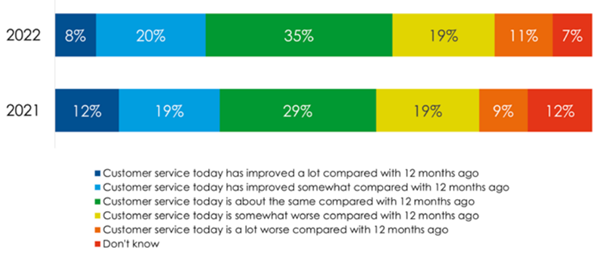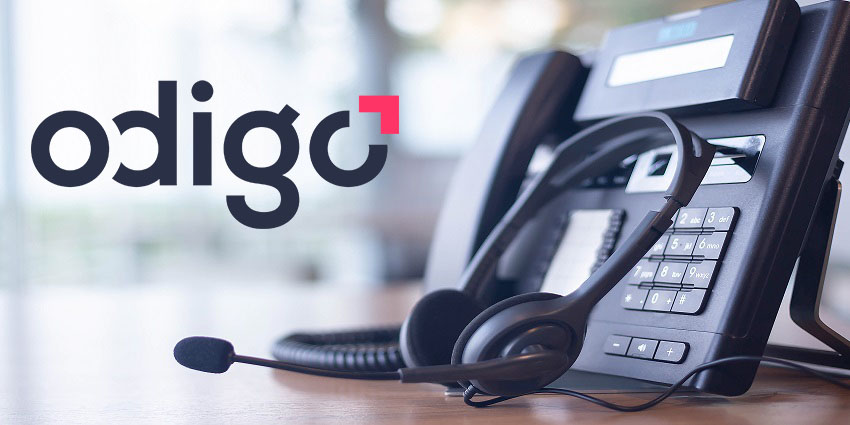Recent research from Citizens Advice reveals that customer satisfaction in the energy sector has reached its lowest level since its records began.
Yet, the problem extends far beyond the energy sector. A 2022 study – “Voice of the Contact Centre Consumer 2022” – highlights how service standards have flatlined since 2021, despite many operations at the time being deeply entrenched in pandemic-induced uncertainty.
Indeed, the following graphic shows that only 28 percent of contact centre leaders believe that the service they offer has improved since 2021. Alternatively, 30 percent state that it is worse.

Of course, with service teams settling into new hybrid environments, contact centre systems evolving, and self-service coming to the fore, it is easy to assume customer support would advance.
However, the same problems – such as long wait times, limited contact centre knowledge, and minimal agent coaching – continue to rear their ugly heads.
Why is this happening? Many point the finger at ill-conceived digital transformation programmes.
Is Digital Service Not Delivering?
Recent studies suggest that many initiatives to improve digital service experiences are not having the desired impact in increasing customer satisfaction and lowering contact centre strain.
Excellent examples of this phenomenon include:
- Proactive Outreach Woes – Gartner research highlights that two-thirds of customers have contacted customer service after receiving proactive notifications from a brand, primarily as they caused confusion.
- Underwhelming Contact Automation – Conversational AI has reduced call volumes by as little as two percent, according to a recent example shared by CX analyst Andrew Moorhouse.
- Poor Call Deflection Strategies – As a Forbes article suggests: “When your digital customer support focuses on deflection, everyone loses.”
Yet, perhaps the most staggering statistic into the plight of digital service comes from the CCMA study, which uncovers a drop in self-service satisfaction across numerous contact reasons.
Take customer complaints as an example. Just 28 percent of customers are now willing to self-serve them, compared to 34 percent just 12 months ago.
As referenced within the report, Anita Renyard, Senior Manager at TSB, believes that this concerning trend may indicate declining levels of customer trust. She states:
Some of the self-serve solutions that were offered during the pandemic weren’t great and sometimes you feel like ‘no, I want to almost see the whites of the eyes of the people and get a commitment.
Of course, the temptation to automate service more and more is often overwhelming. Yet, Renyard reminds us of the significance of striking the ideal balance of human and automated assistance. Get it wrong, and familiar service issues will arise.
Not only will these take the wind from the service team’s sails, but customers will grow increasingly angry, taking it out on the unfortunate agents.
What do Customer Service Leaders Think?
Of course, half-baked digital transformation initiatives are not the only potential cause of customer service woes. Recruitment struggles, knowledge sharing failures, and budget limitations are additional obstacles that many contact centres must still overcome.
However, perhaps this is still only scratching the surface. Digging deeper, the CCMA report notes the thoughts of several customer service leaders.
For example, Andy Davies, Head of Service and Delivery at Virgin Wines, believes that many brands have been slow to pivot from the pandemic and adjust to the new status quo. He says:
Customers across retail can become frustrated when they still hear providers say ‘we’ve got a COVID problem, and we’ve got a staff problem.’ Also, some customers are going through financial difficulties which could only contribute to their frustration.
Indeed, these tricky times may increase the strain on service teams, forcing them to engage in more emotionally challenging calls that take their toll on agents and increase handling times.
Building on this point, Viv Kelly, Head of Customer Service at Shell Energy, adds:
Our people have been having an increasingly difficult time with frustrated customers. I wonder how the psyche of the nation has changed as a result of the pandemic.
Indeed, these difficulties could inflame consumer negativity. But, it is also worth noting how the current economic climate may influence the psyche of agents.
Interestingly, the BT call centre recently went viral for opening up a food bank for its service reps, underlining how many agents are facing financial troubles, which is a significant well-being concern.
Alongside this, rising consumer expectations, challenging conversations, and chronic understaffing will continue to crank the pressure cooker service teams and take their toll on CX.
How Can Companies Revive Their Customer Service?
The prominence of flawed proactive support, automation, and conversational AI initiatives indicates an incremental approach to digital transformation – which builds customer confidence – is perhaps best practice for many.
Instead of the big bang transformation plans, apply caution. Work with knowledgeable partners and follow a “crawl, walk, run” philosophy.
Such an approach learns from small tests instead of massive failures and optimizes digital service plans before embedding them. Creating such a workflow increases the chances of long-term success.
Of course, service level pressures and recruitment struggles may upset the applecart and induce panic automation spending. However, quick fixes are a rarity in the customer support world. The overarching goal should be to “do” every channel well.
What does this look like? Meticulously maximizing goals for customers, agents, and the business. Meeting the needs of these three stakeholders is central to the philosophy of Odigo, the next-generation CCaaS provider.
Detailing this, Neil Titcomb, Managing Director UKI at Odigo, tells the CCMA:
Odigo’s customer experience mission revolves around the intelligent application of our innovative Contact Centre as a Service (CCaaS) solution. We are passionate that technology can bring benefits to customers, agents, and businesses.
In a space seemingly on the decline, such thinking is refreshing and brings customer service back to its basics.
One such old but golden basic – especially in these times of financial turbulence – is happy agents = happy customers. It is a self-reflecting principle that underscores the value of an engaged, happy team.
Not only is this the bedrock of a positive culture, but it will likely increase retention and release the pressure valve on recruitment and onboarding teams.
By fixating on agent welfare and support – alongside an incremental digital service approach that accounts for the basics of customer service – companies may begin to stop the rot of service.
Is your digital customer service transformation strategy failing to yield the desired results? If so, Odigo’s team of experts are here to help. To find out more and reach out to them today visit: www.odigo.com/en-gb/







